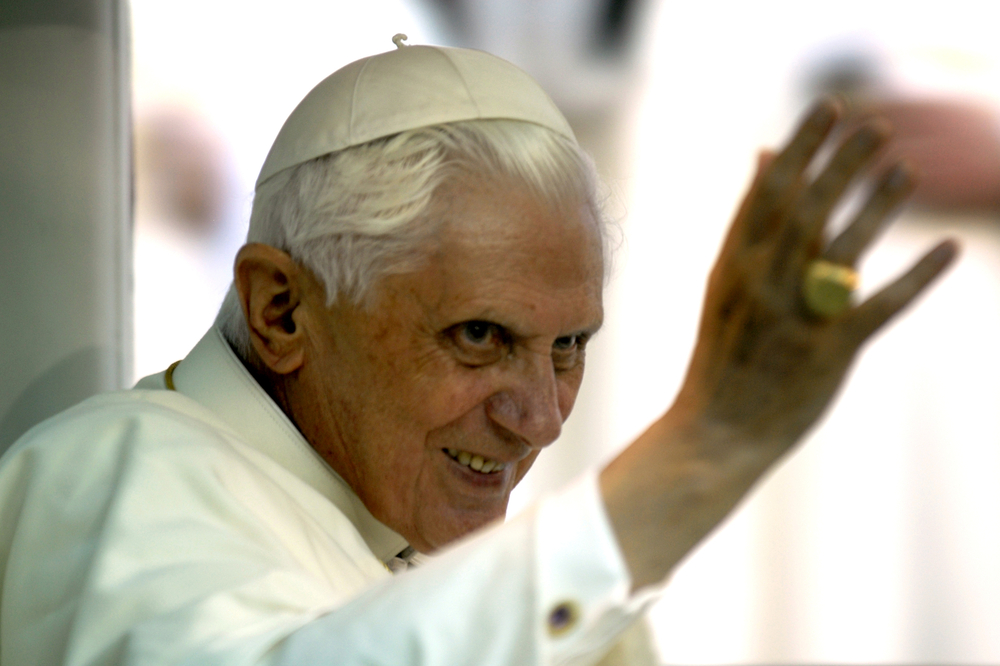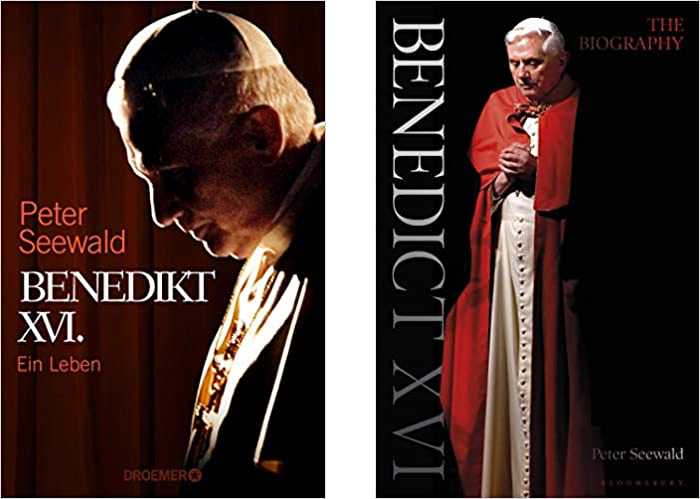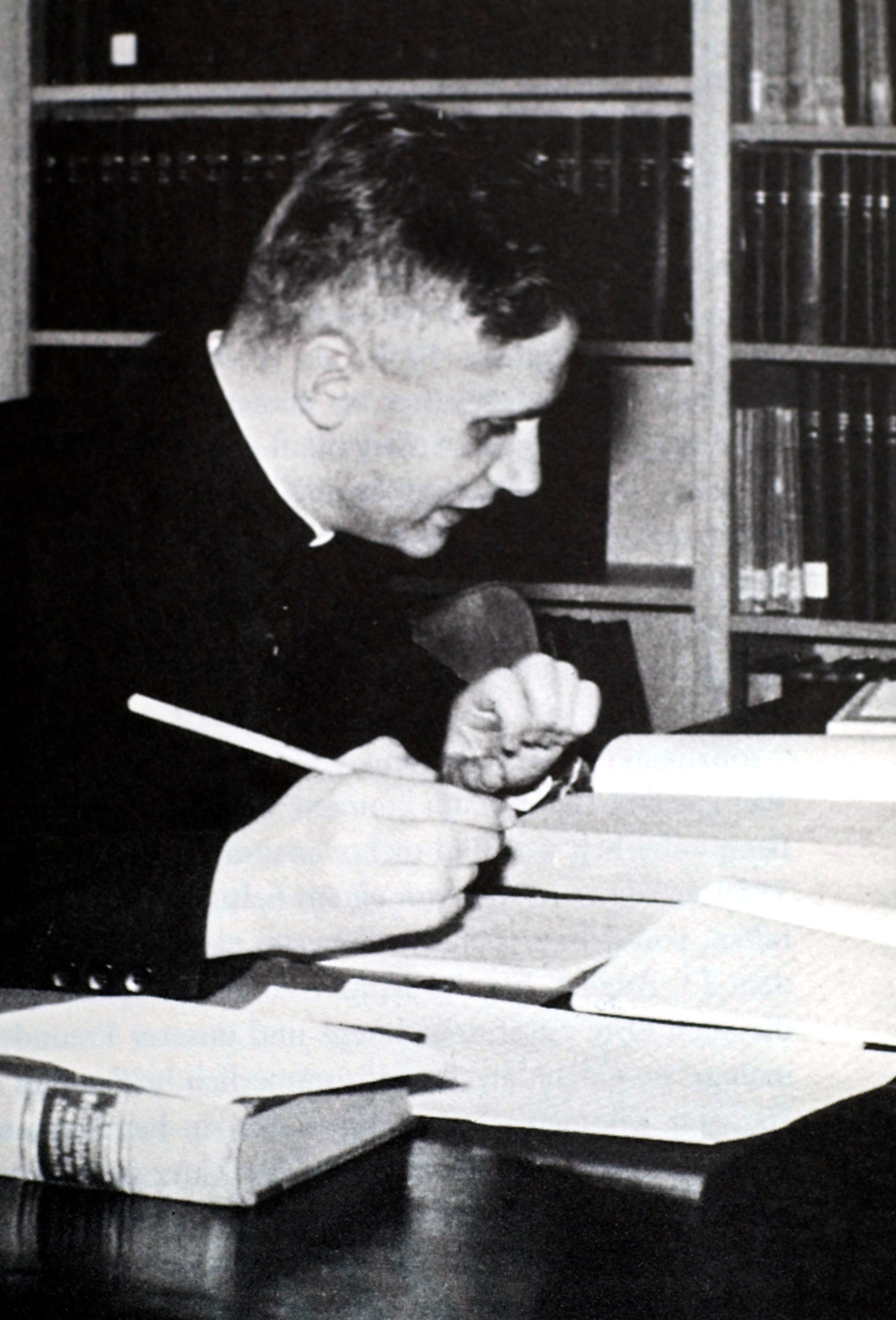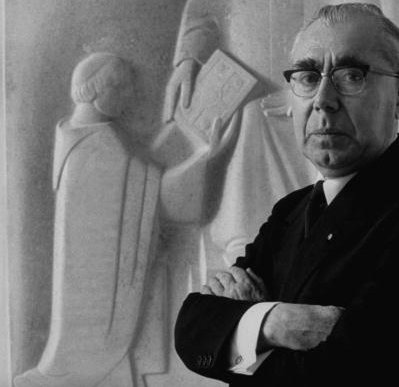Subjective “theology of emotion” without precise definitions…
New Biography of Benedict XVI confirms: Ratzinger was recognized as ‘Dangerous Modernist’ early on

A comprehensive biography of Joseph Ratzinger — “Pope Emeritus” Benedict XVI — has just been published in Germany by Peter Seewald. At 1150 pages, it is a massive tome. It is well documented, contains numerous full-color photos, and includes a name index. The book is divided into six major periods of Ratzinger’s life and has a total of 74 chapters. The work also includes an epilogue and 8 pages of a final interview with the man known as Benedict XVI.
The title of the German original edition of this biography is Benedikt XVI.: Ein Leben (“Benedict XVI: A Life”), and the publisher is Droemer Verlag. In November 2020 it will be released in English translation, in more than one volume, under the title Benedict XVI: The Biography. The publisher will be Bloomsbury Continuum.
Although Life Site has already reported on a few explosive bits and pieces found in the tome, the biography contains some that we anticipate Life Site (or any other web site of that or similar editorial position) will not volunteer to write about. This is where Novus Ordo Watch comes in.

The covers of the German and the forthcoming English editions
From the beginning of his academic career, Ratzinger has been in love with theological novelty, in defiance of Pope St. Pius X’s exhortation: “Far, far from the clergy be the love of novelty!” (Encyclical Pascendi, n. 49).
The Church’s recommended antidote to doctrinal novelty is strict adherence to the Angelic Doctor, St. Thomas Aquinas (1225-1274), and to his scholastic method. For this reason, St. Pius X decreed:
In the first place, with regard to studies, We will and strictly ordain that scholastic philosophy be made the basis of the sacred sciences. … And let it be clearly understood above all things that when We prescribe scholastic philosophy We understand chiefly that which the Angelic Doctor has bequeathed to us, and We, therefore, declare that all the ordinances of Our predecessor [Leo XIII] on this subject continue fully in force, and, as far as may be necessary, We do decree anew, and confirm, and order that they shall be strictly observed by all. In seminaries where they have been neglected it will be for the Bishops to exact and require their observance in the future; and let this apply also to the superiors of religious orders. Further, We admonish professors to bear well in mind that they cannot set aside St. Thomas, especially in metaphysical questions, without grave disadvantage.
(Pope Pius X, Encyclical Pascendi, n. 45; underlining added.)
The 1917 Code of Canon Law, promulgated by Pope Benedict XV, legislates for Catholic seminaries: “Professors shall treat studies in rational theology and philosophy and the instruction of students in these disciplines according to the system, teaching, and principles of the Angelic Doctor and hold to them religiously” (Canon 1366 §2; Peters translation).
In 1923, Pope Pius XI summarized the Church’s esteem for St. Thomas and bestowed a new title upon him:
He enjoyed a more than human reputation for intellect and learning and [Pope] Pius V was therefore moved to enroll him officially among the holy Doctors with the title of Angelic. Again, could there be any more manifest indication of the very high esteem in which this Doctor is held by the Church than the fact that the Fathers of Trent resolved that two volumes only, Holy Scripture and the Summa Theologica, should be reverently laid open on the altar during their deliberations? And in this order of ideas, to avoid recapitulating the innumerable testimonies of the Apostolic See, We are happy to recall that the philosophy of Aquinas was revived by the authority and at the instance of Leo XIII; the merit of Our illustrious Predecessor in so doing is such, as We have said elsewhere, that if he had not been the author of many acts and decrees of surpassing wisdom, this alone would be sufficient to establish his undying glory. Pope Pius X of saintly memory followed shortly afterwards in his footsteps, more particularly in his Motu Proprio Doctoris Angelici, in which this memorable phrase occurs: “For ever since the happy death of the Doctor, the Church has not held a single Council but he has been present at it with all the wealth of his doctrine.” Closer to Us, Our greatly regretted [=mourned] Predecessor Benedict XV repeatedly declared that he was entirely of the same opinion and he is to be praised for having promulgated the Code of Canon Law in which “the system, philosophy and principles of the Angelic Doctor” are unreservedly sanctioned. We so heartily approve the magnificent tribute of praise bestowed upon this most divine genius that We consider that Thomas should be called not only the Angelic, but also the Common or Universal Doctor of the Church; for the Church has adopted his philosophy for her own, as innumerable documents of every kind attest. It would be an endless task to explain here all the reasons which moved Our Predecessors in this respect, and it will be sufficient perhaps to point out that Thomas wrote under the inspiration of the supernatural spirit which animated his life and that his writings, which contain the principles of, and the laws governing, all sacred studies, must be said to possess a universal character.
(Pope Pius XI, Encyclical Studiorum Ducem, n. 11; underlining added.)
The idea that the modern age, with all its (both real and supposed) advancements, required a different philosophy and theology as that exemplified by Aquinas, had already been condemned as an error in 1864 by Pope Pius IX in his famous Syllabus of Errors: “The method and principles by which the old scholastic doctors cultivated theology are no longer suitable to the demands of our times and to the progress of the sciences” (error no. 13).
And in 1902, Pope Leo XIII had warned:
It is impossible to approve in Catholic publications a style inspired by unsound novelty which seems to deride the piety of the faithful and dwells on the introduction of a new order of Christian life, on new directions of the Church, on new aspirations of the modern soul, on a new social vocation of the clergy, on a new Christian civilization, and many other things of the same kind.
(Pope Leo XIII, Instruction of the Sacred Congregation of Extraordinary Ecclesiastical Affairs [Jan. 27, 1902]; quoted in Pope Pius X, Encyclical Pascendi, n. 55; underlining added.)
A great many more quotes like this could be furnished, but these suffice to establish in what high regard Holy Mother Church holds the Angelic and Universal Doctor, and that his doctrine and the scholastic method are especially suitable for remaining safely within the bounds of orthodoxy, and are thus highly recommended for refuting the errors of the Modernists and their intellectual progeny.
Thus the Church’s position in favor of St. Thomas and against theological innovation could not be more clear.

Fr. Joseph Ratzinger in 1960
(Photo Credit: DB/picture-alliance/dpa/AP Images)
Alas, the papally enjoined attitude towards Aquinas and scholasticism was not shared by the budding academic Joseph Ratzinger. In his memoirs, the future “cardinal” and “Pope” admits a distaste for St. Thomas and scholasticism in general:
I had difficulties in penetrating the thought of Thomas Aquinas, whose crystal-clear logic seemed to me to be too closed in on itself, too impersonal and ready-made. This may also have had something to do with the fact that Arnold Wilmsen, the philosopher who taught us Thomas, presented us with a rigid, neoscholastic Thomism that was simply too far afield from my own questions.
(Joseph Ratzinger, Milestones: Memoirs 1927-1977 [San Francisco, CA: Ignatius Press, 1998], p. 44)
Wisely had Pope St. Pius X warned that a love of novelty, combined with a disdain for scholasticism, is a sure sign of Modernism: “…the passion for novelty is always united in them with hatred of scholasticism, and there is no surer sign that a man is tending to Modernism than when he begins to show his dislike for the scholastic method” (Pascendi, n. 42). Not surprisingly, “Pope” Francis is likewise on record denouncing what he calls “decadent scholasticism”, but that’s not our topic now.
Ratzinger, then, was showing his true colors early on: Barely ordained, he had already been tainted by Modernist ideas and methods, and the rotten fruits of this were already making themselves known. Hence it comes as no surprise that it was reported in the press that during the pontificate of Pope Pius XII (1939-58), Ratzinger was tagged “supect of heresy” by the Holy Office. While we do not know precisely what incident or writing of his merited him that inglorious label, the anecdote we will now share from Seewald’s new biography may very well be what got him reported to the Holy Office in 1956.
In order to hold a chair at a German university, it is required for a professor to submit a so-called Habilitationsschrift, which is essentially a post-doctoral dissertation. This Ratzinger did in late 1955 at the University of Munich. Merely submitting it is not enough, of course — it must also be approved.
In Ratzinger’s case, the Habilitationsschrift needed to receive not only the approval of his own theological mentor, Fr. Gottlieb Söhngen (1892-1971), but also that of Fr. Michael Schmaus (1897-1993), a celebrated and accomplished theologian who held the chair of dogmatic theology.
This is where it gets interesting — because Schmaus did not approve.

Fr. Schmaus noticed Ratzinger’s Modernism early on and tried to stall his academic career
(Photo Credit: David Lees/The LIFE Images Collection via Getty Images)
Although Ratzinger himself has already spoken in his memoirs about the roadblocks he enountered with his post-doctoral dissertation, Seewald’s biography now reveals more details. For copyright reasons, we must unfortunately keep our direct quotations to a minimum.
According to the testimony shared in Benedikt XVI.: Ein Leben, Fr. Eugen Biser (1918-2014), who succeeded the notorious Modernist Fr. Karl Rahner (1904-84) in holding the Romano Guardini Chair at the University of Munich, recounts Schmaus’ attitude towards the young Fr. Ratzinger thus: “Schmaus almost regarded him as dangerous. Ratzinger was considered to be a progressivist who causes fixed bastions to totter” (p. 308; our translation).
If that wasn’t a stunningly accurate, nay prophetic, assessment of the blossoming intellectual! Better confirmation of Schmaus’ judgment could hardly be asked for than Ratzinger’s own 1982 book Theologische Prinzipienlehre. It was released in English translation five years later as Principles of Catholic Theology. There the author, who by that time had already risen to the position of Prefect of the Congregation for the Doctrine of the Faith, states point-blank:
…there can be no return to the Syllabus [of Pius IX], which may have marked the first stage in the confrontation with liberalism and a newly conceived Marxism but cannot be the last stage. In the long run, neither embrace nor ghetto can solve for Christians the problem of the modern world. The fact is, as Hans Urs von Balthasar pointed out as early as 1952, that the “demolition of the bastions” is a long-overdue task.
(Joseph Ratzinger, Principles of Catholic Theology [San Francisco, CA: Ignatius Press, 1987], p. 391)
Here the hardened Modernist reveals that he does not accept the Syllabus of Errors’ condemnations as communicating perennially valid truths but considers them as merely time-conditioned reactions which, although they have their legitimacy and usefulness at that particular point in time, merely constitute one “stage” in a continutally unfolding historical process. That is the error known as historicism. By arguing that both “embrace” (thesis) and “ghetto” (antithesis) are unacceptable and must give rise to an eventual solution that transcends both (synthesis), Ratzinger once again confirms that he is a Hegelian.
Returning now to Seewald’s account of Schmaus’ critical assessment of the “master student” Ratzinger, we discover even more interesting details. Seewald quotes Schmaus as complaining (once again with stunning accuracy): “Ratzinger knows how to wrap things in flowery formulations, but where is the core of the matter?” (p. 308; our translation). Touché!
Examples abound of how spot-on the dogmatic theology professor’s judgment was. One need but examine what Ratzinger said in a 1981 sermon about original sin, during his time as “Archbishop” of Munich. Take a look and ask yourself if, after he is done, there is anything left of the Catholic notion of original sin. He pretends to answer the question, what is original sin? In fact, see if you can summarize in one or two sentences what he even said:
Finding an answer to this requires nothing less than trying to understand the human person better. It must once again be stressed that no human being is closed in upon himself or herself and that no one can live of or for himself or herself alone. We receive our life not only at the moment of birth but every day from without – from others who are not ourselves but who nonetheless somehow pertain to us. Human beings have their selves not only in themselves but also outside of themselves: they live in those whom they love and in those who love them and to whom they are ‘present.’ Human beings are relational, and they possess their lives – themselves – only by way of relationship. I alone am not myself, but only in and with you am I myself. To be truly a human being means to be related in love, to be of and for. But sin means the damaging or the destruction of relationality. Sin is a rejection of relationality because it wants to make the human being a god. Sin is loss of relationship, disturbance of relationship, and therefore it is not restricted to the individual. When I destroy a relationship, then this event – sin – touches the other person involved in the relationship. Consequently sin is always an offense that touches others, that alters the world and damages it. To the extent that this is true, when the network of human relationships is damaged from the very beginning, then every human being enters into a world that is marked by relational damage. At the very moment that a person begins human existence, which is a good, he or she is confronted by a sin-damaged world. Each of us enters into a situation in which relationality has been hurt. Consequently each person is, from the very start, damaged in relationships and does not engage in them as he or she ought. Sin pursues the human being, and he or she capitulates to it.
(Joseph Ratzinger, ‘In the Beginning…’: A Catholic Understanding of the Story of Creation and the Fall, trans. by Boniface Ramsey, O.P. [Grand Rapids, MI: William B. Eerdmans Publishing Company, 1995], pp. 72-73; view scan here.)
Got that?!
How far removed this Ratzingerian drivel is from the Catholic doctrine on original sin, is explained in our dedicated post on this matter:
But there is more.
Fr. Alfred Läpple (1915-2013) was one of Ratzinger’s seminary professors. In an interview with Seewald some time ago, Läpple recalled that Fr. Schmaus had
told the junior theologian to his face: “You just talk and avoid precise definitions.” Läpple sympathized with the criticism: “Ratzinger favors a theology of emotion. He shies away from clear definitions. Sic et non — it is thus or it is not thus — he never went by that medieval maxim. He does not love strict definitions but wants to express things in a new way and puts that together as an artist puts together a painting. And in the end one wonders: Just what did he actually say?” Läpple added: “Schmaus was right that he is too emotional, that again and again he comes along with new words and is excited to go from one formulation to the next.”
(Peter Seewald, Benedikt XVI. Ein Leben [Munich: Droemer Verlag], p. 308; our translation.)
Just what did he actually say! What a perfectly appropriate reaction to the pretentious poppycock Ratzinger cranks out as extremely profound theology that (supposedly) speaks to modern man. The fruits tell a different story: The Vatican II Church is collapsing under its own irrelevance, the well-deserved consequence of the spiritual and intellectual barrenness produced by its haughty abandonment of true Catholicism. For over five decades, the “New Theologians” have had free rein, and the results are more than visible in the theological, philosophical, and spiritual wasteland all around us, epitomized in the apostate Jorge Bergoglio (“Pope” Francis), who is still trying to sell the wasteland as an exquisite, fruitful vineyard.
Fr. Schmaus’ rejection of Ratzinger’s theology is all the more significant inasmuch as Schmaus was no Fr. Garrigou-Lagrange himself. A suit-and-tie priest, Schmaus favored a new “approach” to theology; and had his own theological mentor not intervened in Rome at the time, his first edition of Katholische Dogmatik (“Catholic Dogmatics”) would have been placed on the Index of Forbidden Books. The Biographisch-Bibliographisches Kirchenlexikon, which is a work comparable to the American Catholic Encyclopedia, notes:
Naturally there were not wanting those for whom the novelty of approach, of language, and of method [in Schmaus’ theology] seemed too radical … so that it was only through the intervention of his mentor Martin Grabmann with Pius XII that the first volume [of his Catholic Dogmatics] was kept from being placed on the Index, which would have meant the early end of Schmaus’ academic career.
(Manfred Eder, in Biographisch-Bibliographisches Kirchenlexikon, vol. IX, s.v. “Schmaus, Michael”; our translation.)
In other words, Schmaus wasn’t the kind to find Modernism and Modernists under every rock. For him to take measures to prevent Ratzinger from succeeding academically due to Modernistic tendencies says a lot — about Ratzinger. And he was by no means the only one to notice the danger the up-and-coming theologian presented. Seewald reports that “some of the professors [on the university’s 15-member faculty board] likewise spoke of Ratzinger’s dangerous Modernism” (p. 308), an assessment based on the subjectivist view of the concept of revelation he put forward.
Obviously, we all know that despite his good efforts, Fr. Schmaus did not ultimately succeed in preventing Fr. Ratzinger’s “career.” Not only did the young theologian become an influential and popular lecturer at universities, he became a peritus for Cardinal Josef Frings at the Second Vatican Council, went on to become “Cardinal-Archbishop” of Munich-Freising, was appointed Prefect of the Vatican’s Congregation for the Doctrine of the Faith, and, of course, was elected head of the Vatican II Sect as “Benedict XVI” in 2005, a position from which he resigned in 2013.
The idea that Ratzinger is a great bulldog of Catholic orthodoxy is a myth. It is fantasy. Our topical page on Benedict XVI makes that clear. For example, in 1972, he even supported giving Holy Communion to those living in public adultery. While in recent years he retracted that conclusion, he has not disavowed the theological reasoning behind it.
Modernism is the “synthesis of all heresies”, Pope St. Pius X wrote in 1907 (Encyclical Pascendi, n. 39), and we can see all around us just how true that is. The same Pope denounced the Modernists as “the most pernicious of all the adversaries of the Church” and noted that, while “leaving out of account the internal disposition of the soul, of which God alone is the Judge,” they manifest themselves by “their tenets, their manner of speech, and their action” (Pascendi, n. 3).
Thus Fr. Michael Schmaus saw that Joseph Ratzinger is one of them.
Image sources: shutterstock.com / Amazon / Associated Press / Getty Images
Licenses: paid / fair use / rights-managed / rights-managed



No Comments
Be the first to start a conversation